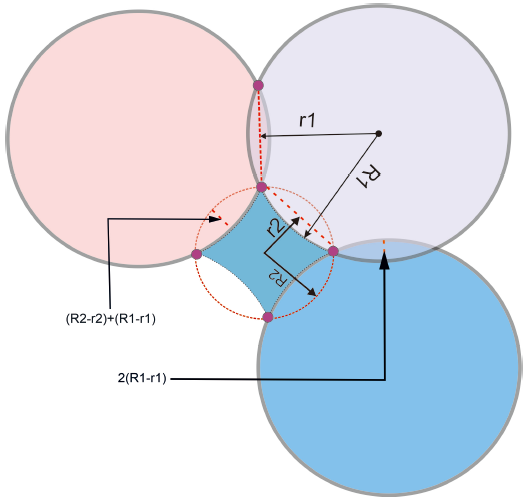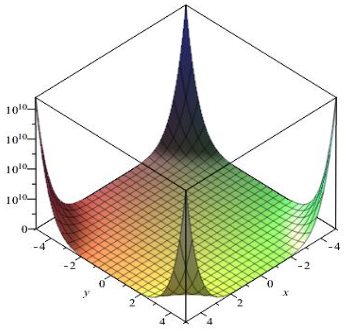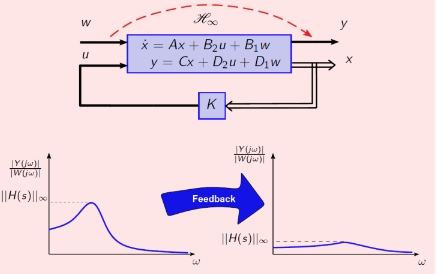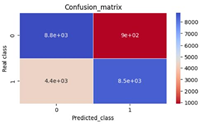The study of chaotic dynamics of an eco-epidemiological predator-prey model with alternative food
Abstract
Parasites can alter the quality and quantity of participants. On the other hand, the spread of diseases between individuals or species is an important research topic. Here we consider a tritrophic food model in which bacteria spread among the animal's environment where other nutrients are present. We analyze the local stability of the model around the efficiency of the equation. We also report significant numbers of offspring in terms of ecology and disease and use these numbers to analyze community structure of the sample. We started from this situation as a model. Our numerical results show that at low infection level the body causes conflict, but at high infection level conflict prioritizes safety. Our findings therefore challenge previous models’ predictions that the parasite has a negative impact. We also looked at the impact of other foods on chaotic dynamics. When other nutrients increase, stress does not change, but when other nutrients decrease, chaos disappears and the disease among animals is eliminated from the body.
References
[1]Anderson RM, May RM. Infectious diseases and population cycles of forest insects. Science 1980; 210(4470): 658–661. doi: 10.1126/science.210.4470.658
[2]Dobson AP. The population biology of parasite-induced changes in host behavior. Quarterly Review of Biology 1988; 63(2): 139–165. doi: 10.1086/415837
[3]Grenfell BT, Bolker BM, Kleczkowski A. Seasonality and extinction in chaotic metapopulations. Proceedings: Biological Sciences 1995; 259(1354): 97–103
[4]Hilker FM, Schmitz K. Disease-induced stabilization of predator-prey oscillations. Journal of Theoretical Biology 2008; 255(3): 299–306. doi: 10.1016/j.jtbi.2008.08.018
[5]Courchamp F, Chapuis JL, Pascal M. Mammal invaders on islands: Impact, control and control impact. Biological Reviews of the Cambridge Philosophical Society 2003; 78(3): 347–383. doi: 10.1017/s1464793102006061
[6]Mandal AK, Kundu K, Chatterjee P, Chattopadhyay J. An eco-epidemiological study with Parasitic attack and alternative prey. Journal of Biological Systems 2009; 17(2): 269–282. doi: 10.1142/S0218339009002776
[7]Anderson RM, May RM. The invasion, persistence and spread of infectious diseases within animal and plant communities. Philosophical Transactions of the Royal Society B 1986; 314(1167): 533–570. doi: 10.1098/rstb.1986.0072
[8]Hsieh YH, Hsiao CK. Predator-prey model with disease infection in both populations. Mathematical Medicine and Biology 2008; 25(3): 247–266. doi: 10.1093/imammb/dqn017
[9]Grenfell BT, Wilson K, Isham VS, et al. Modelling patterns of parasite aggregation in natural populations: Trichostrongylid nematode-ruminant interactions as a case study. Parasitology 1995; 111: S135–S151. doi: 10.1017/s0031182000075867
[10]Anderson RM, May RM. Infectious Diseases of Humans: Dynamics and Control. Oxford University Press; 1991.
[11]Godfray HCJ, Grenfell BT. The continuing quest for chaos. Trends in Ecology & Evolution 1993; 8(2): 43–44. doi: 10.1016/0169-5347(93)90155-i
[12]Hochberg ME. Non-linear transmission rates and the dynamics of infectious disease. Journal of Theoretical Biology 1991; 153(3): 301–321. doi: 10.1016/s0022-5193(05)80572-7
[13]McCann K, Yodzis P. Nonlinear dynamics and population disappearances. The American Naturalist 1994; 144(5): 873–879. doi: 10.1086/285714
[14]Nogales M, Martı´n A, Tershy BR, et al. A review of feral cat eradication on islands. Conservation Biology 2004; 18(2): 310–319. doi: 0.1111/j.1523-1739.2004.00442.x
[15]Schaffer WM, Kot M. Chaos in ecological systems: The coals that Newcastle forgot. Trends in Ecology & Evolution 1986; 1(3): 58–63. doi: 10.1016/0169-5347(86)90018-2
[16]Dobson AP, Keymer AE. Life history models. In: Crompton DWT, Nickol BB (editors). Biology of the Acanthocephala. Cambridge University Press; 1985. pp. 347–384. doi: 10.1007/978-3-642-61317-3_6
[17]Hadeler KP, Freedman HI. Predator-prey populations with parasitic infection. Journal of Mathematical Biology 1989; 27: 609–631. doi: 10.1007/BF00276947
[18]Charnov EL. Optimal foraging: The marginal value theorem. Theoretical Population Biology 1976; 9(2): 129–136. doi: 10.1016/0040-5809(76)90040-X
[19]Diekmann O, Heesterbeek JAP, Metz JAJ. On the definition and the computation of the basic reproductive ratio R0 in models for infectious diseases in heterogeneous populations. Journal of Mathematical Biology 1990; 28: 365–382. doi: 10.1007/BF00178324
[20]Engbert R, Drepper FR. Chance and chaos in population biology—Models of recurrent epidemics and food-chain dynamics. Chaos Solitons & Fractals 1994; 4(7): 1147–1169. doi: 10.1016/0960-0779(94)90028-0
[21]Venturino E. Epidemics in predator-prey model: Disease in the predators. Mathematical Medicine and Biology: A Journal of the IMA 2002; 19(3): 185–205. doi: 10.1093/imammb/19.3.185
[22]Venturino E. Epidemics in predator-prey models: Disease in the prey. In: Arino O, Axelrod D, Kimmel M (editors). Mathematical Population Dynamics: Analysis of Heterogeneity. Theory of Epidemics. Wuerz Publishing, Winnipeg, Canada; 1995. pp. 381–393. doi: 10.1016/j.tpb.2004.06.010
[23]Xiao Y, Van Den Bosch F. The dynamics of an eco-epidemic model with biological control. Ecological Modelling 2003; 168(1–2): 203–214. doi: 10.1016/S0304-3800(03)00197-2.
[24]Haque M, Venturino E. The role of transmissible disease in Holling-Tanner predator-prey model. Theoretical Population Biology 2006; 70(3): 273–288. doi: 10.1016/j.tpb.2006.06.007
[25]Beltrami E, Carroll TO. Modelling the role of viral disease in recurrent phytoplankton blooms. Journal of Mathematical Biology 1994; 32: 857–863. doi: 10.1007/BF00168802
[26]Venturino E. The influence of disease on Lotka-Volterra systems. The Rocky Mountain Journal of Mathematics 1994; 24(1): 381–402.
[27]Greenhalgh D, Haque M. A predator-prey model with disease in the prey species only. Mathematical Methods in the Applied Sciences 2007; 30(8): 911–929. doi: 10.1002/mma.815
[28]Singh BK, Chattopadhyay J, Sinha S. The role of virus infection in a simple phytoplankton zooplankton system. Journal of Theoretical Biology 2004; 231(2): 153–166. doi: 10.1016/j.jtbi.2004.06.010
[29]Hastings A, Hom CL, Ellner S, et al. Chaos in ecology: Is mother nature a strange attractor? Annual Review of Ecology and Systematics 1993; 24(1): 1–33. doi: 10.1146/annurev.es.24.110193.000245
[30]Schaffer WM, Kot M. Chaos in ecological systems: The coals that Newcastle forgot. Trends in Ecology & Evolution 1986; 1(3): 58–63. doi: 10.1016/0169-5347(86)90018-2
[31]Courchamp F, Sugihara G. Modeling the biological control of an alien predator to protect island species from extinction. Ecological Application 1999; 9(1): 112–123. doi: 10.1890/1051-0761(1999)009[0112:MTBCOA]2.0.CO;2
[32]Lotka AJ. Relation between birth rates and death rates. Science 1907; 26(653): 21–22. doi: 10.1126/science.26.653.21-a
[33]Fenton A, Rands SA. The impact of parasite manipulation and predator foraging behavior on predator-prey communities. Ecology 2006; 87(11): 2832–2841. doi: 10.1890/0012-9658(2006)87[2832:tiopma]2.0.co;2
[34]Hethcote HW, Wang W, Han W, Ma Z. A predator-prey model with infected prey. Theoretical Population Biology 2004; 66(3): 259–268. doi: 10.1016/j.tpb.2004.06.010
[35]Han L, Ma Z, Hethcote HW. Four predator prey models with infectious diseases. Mathematical and Computer Modelling 2001; 34(7–8): 849–858. doi: 10.1016/S0895-7177(01)00104-2
[36]Chatterjee S, Bandyopadhyay M, Chattopadhyay J. Proper predation makes the system disease free—Conclusion drawn from an eco-epidemiological model. Journal of Biological Systems 2006; 14(4): 599–616. doi: 10.1142/S0218339006001970
[37]Hastings A, Powell T. Chaos in three-species food chain. Ecology 1991; 72(3): 896–903. doi: 10.2307/1940591
[38]Harmon JP, Ives AR, Losey JE, et al. Coleomegilla maculata (Coleoptera: Coccinellidae) predation on pea aphids promoted by proximity to dandelions. Oecologia 2000; 125(4): 543–548. doi: 10.1007/s004420000476
[39]Chattopadhyay J, Arino O. A predator-prey model with disease in the prey. Nonlinear Analysis: Theory, Methods & Applications 1999; 36(6): 747–766. doi: 10.1016/S0362-546X(98)00126-6
[40]Freedman HI. A model of predator-prey dynamics modified by the action of parasite. Mathematical Biosciences 1990; 99(2): 143–155. doi: 10.1016/0025-5564(90)90001-F
[41]Fryxell JM, Lundberg P. Diet choice and predator-prey dynamics. Evolutionary Ecology 1994; 8: 407–421. doi: 10.1007/BF01238191
[42]Haque M, Venturino E. An ecoepidemiological model with disease in predator: The ratio-dependent case. Mathematical Methods in the Applied Sciences 2007; 30(14): 1791–1809. doi: 10.1002/mma.869
Copyright (c) 2023 Prodip Roy, Abhishek Sarkar, Kulbhushan Agnihotri, Krishna Pada Das

This work is licensed under a Creative Commons Attribution 4.0 International License.











